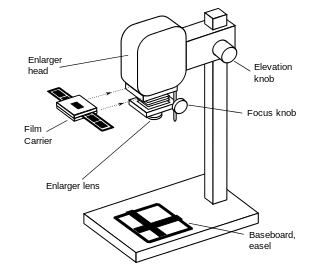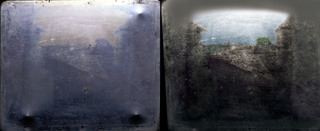
A photograph is an image created by light falling on a photosensitive surface, usually photographic film or an electronic image sensor, such as a CCD or a CMOS chip. Most photographs are now created using a smartphone or camera, which uses a lens to focus the scene's visible wavelengths of light into a reproduction of what the human eye would see. The process and practice of creating such images is called photography.

Calotype or talbotype is an early photographic process introduced in 1841 by William Henry Fox Talbot, using paper coated with silver iodide. Paper texture effects in calotype photography limit the ability of this early process to record low contrast details and textures.

The cyanotype is a slow-reacting, economical photographic printing formulation sensitive to a limited near ultraviolet and blue light spectrum, the range 300 nm to 400 nm known as UVA radiation. It produces a monochrome, blue coloured print on a range of supports, often used for art, and for reprography in the form of blueprints. For any purpose, the process usually uses two chemicals: ferric ammonium citrate or ferric ammonium oxalate, and potassium ferricyanide, and only water to develop and fix. Announced in 1842, it is still in use.

The albumen print, also called albumen silver print, is a method of producing a photographic print using egg whites. Published in January 1847 by Louis Désiré Blanquart-Evrard, it was the first commercial process of producing a photo on a paper base from a negative, previous methods - such as the daguerreotype and the tintype - having been printed on metal. It became the dominant form of photographic positives from 1855 to the start of the 20th century, with a peak in the 1860–90 period. During the mid-19th century, the carte de visite became one of the more popular uses of the albumen method. In the 19th century, E. & H. T. Anthony & Company were the largest makers and distributors of albumen photographic prints and paper in the United States.

Color photography is photography that uses media capable of capturing and reproducing colors. By contrast, black-and-white or gray-monochrome photography records only a single channel of luminance (brightness) and uses media capable only of showing shades of gray.

An enlarger is a specialized transparency projector used to produce photographic prints from film or glass negatives, or from transparencies.

A tintype, also known as a melanotype or ferrotype, is a photograph made by creating a direct positive on a thin sheet of metal, colloquially called 'tin', coated with a dark lacquer or enamel and used as the support for the photographic emulsion. It was introduced in 1853 by Adolphe Alexandre Martin in Paris, like the daguerreotype was fourteen years before by Daguerre. The daguerreotype was established and most popular by now, though the primary competition for the tintype would have been the ambrotype, that shared the same collodion process, but on a glass support instead of metal. Both found unequivocal, if not exclusive, acceptance in North America. Tintypes enjoyed their widest use during the 1860s and 1870s, but lesser use of the medium persisted into 1930s and it has been revived as a novelty and fine art form in the 21st century. It has been described as the first "truly democratic" medium for mass portraiture.

The term alternative process refers to any non-traditional or non-commercial photographic printing process. Currently, the standard analog photographic printing process for black-and-white photographs is the gelatin silver process. Standard digital processes include the pigment print, and digital laser exposures on traditional color photographic paper.

The megalethoscope is a larger version (mega-) of the alethoscope, which it largely superseded, and both are instruments for viewing single photographs with a lens to enlarge and to create some illusion of three-dimensionality. They were used to view photographic albumen prints that were coloured, perforated and mounted on a curved frame. Night effects were achieved when viewing pictures in transmitted light from a fitted oil or kerosine lamp and a daytime version of the same scene was seen when lit by the reflected light from two side mirrors. They are sophisticated versions of the peep show, and were designed by Carlo Ponti of Venice before 1862. Lke the similar graphoscope which descends from the eighteenth century zograscope predating photography, these devices were, and are, often confused with the stereoscope which was of a different design and effect. Improvements to the megalethoscope over the alethoscope, mainly the addition of a compound lens, are detailed in The Practical Mechanic's Journal of 1867.

The history of photography began with the discovery of two critical principles: The first is camera obscura image projection; the second is the discovery that some substances are visibly altered by exposure to light. There are no artifacts or descriptions that indicate any attempt to capture images with light sensitive materials prior to the 18th century.

John Adams Whipple was an American inventor and early photographer. He was the first in the United States to manufacture the chemicals used for daguerreotypes. He pioneered astronomical and night photography. He was a prize-winner for his extraordinary early photographs of the moon and he was the first to produce images of stars other than the sun. Among those was the star Vega and the Mizar-Alcor stellar sextuple system, which was thought to be a double star until 2009.

Textile printing is the process of applying color to fabric in definite patterns or designs. In properly printed fabrics the colour is bonded with the fibre, so as to resist washing and friction. Textile printing is related to dyeing but in dyeing properly the whole fabric is uniformly covered with one colour, whereas in printing one or more colours are applied to it in certain parts only, and in sharply defined patterns.

Adolfo Farsari was an Italian photographer based in Yokohama, Japan. His studio, the last notable foreign-owned studio in Japan, was one of the country's largest and most prolific commercial photographic firms. Largely due to Farsari's exacting technical standards and his entrepreneurial abilities, it had a significant influence on the development of photography in Japan.
The conservation and restoration of photographs is the study of the physical care and treatment of photographic materials. It covers both efforts undertaken by photograph conservators, librarians, archivists, and museum curators who manage photograph collections at a variety of cultural heritage institutions, as well as steps taken to preserve collections of personal and family photographs. It is an umbrella term that includes both preventative preservation activities such as environmental control and conservation techniques that involve treating individual items. Both preservation and conservation require an in-depth understanding of how photographs are made, and the causes and prevention of deterioration. Conservator-restorers use this knowledge to treat photographic materials, stabilizing them from further deterioration, and sometimes restoring them for aesthetic purposes.

Thomas Sutton was an English photographer, author, and inventor.

The crystoleum, from "crystal" + "oleum" (oil), process was a method of applying colour to an albumen print, popular from c. 1880 – c. 1910.
Ruth Maddison is an Australian photographer. She started photography in the 1970s and continues to make contributions to the Australian visual arts community.

Charles Henry Sawyer (1868-1954) was a painter and photographer in the United States.

Élisabeth Thuillier and Marie-Berthe Thuillier were a mother-daughter team of French colourists. They ran a workshop in Paris, where their employees hand-coloured early films and photographic slides using their plans and colour choices. They are remembered especially for the work they did for the director Georges Méliès.
Photo-crayotypes were an artistic process used for the hand-colouring of photographs by the application of crayons and pigments over a photographic impression.






















